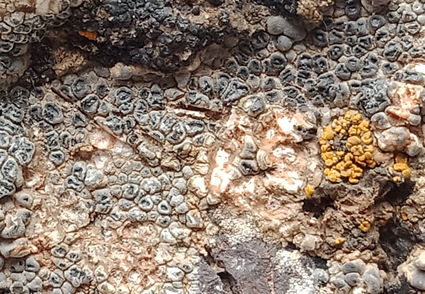Abstract
A new species in Megasporaceae, Oxneriaria pakistanica is described and illustrated from Pakistan. A comparative morpho–anatomical study and ITS–based molecular analyses confirmed its position within the recently resurrected genus, Oxneriaria. The taxon has non-zonate thallus, epruinose, distinctly areolate, 0.5–1.8 mm wide areole, grey to whitish grey at upper surface, prothallus absent, 0.1–2 mm in diameter apothecia, taller hymenium 100–155 µm, deeper hypothecium 90–170 µm, broadly ellipsoid to sub-spherical ascospores 10–18 × 7–10 µm size and chemistry unknown substance detected. Its forms a separate branch in the phylogenetic tree and also distinct from the other known taxa of the genus. Oxneriaria pakistanica sp. nov appeared to be a sister specie to Oxneriaria rivulicola. A detailed comparison and a key to all taxa of Oxneriaria is also given.
References
<p>Gardes, M. & Bruns, T.D. (1993) ITS primers with enhanced specificity for basidiomycetes—application to the identification of mycorrhizae and rusts. <em>Molecular Ecology</em> 2 (2): 113–118. https://doi.org/10.1111/j.1365-294X.1993.tb00005.x</p>
<p>Haji-Moniri, M., Gromakova, A.B., Lőkös, L. & Kondratyuk, S.Y. (2017) New members of the Megasporaceae (Pertusariales, lichen-forming Ascomycota<em>): Megaspora iranica</em> spec. nova and <em>Oxneriaria</em> gen. nova. <em>Acta Botanica Hungarica</em> 59 (3–4): 343–370. https://doi.org/10.1556/034.59.2017.3-4.5</p>
<p>Hale, M.E. (1979) <em>How to know the lichens,</em> WC Brown Co..</p>
<p>Hall, T.A. (1999) BioEdit: a user-friendly biological sequence alignment editor and analysis program for Windows 95/98/NT. <em>Nucleic acids symposium series</em> (Vol. 41, No. 41, pp. 95–98). [London]: Information Retrieval Ltd., c1979–c2000. https://doi.org/10.1556/034.59.2017.3-4.5</p>
<p> </p>
<p>Nimis, P.L. (2016) ITALIC–the information system on Italian lichens. Versions 5.0 University of Trieste. Dept. of Biology. [http://dryades.units.it/italic]</p>
<p>Nordin, A., Björn, O.L. & Tibell, L. (2011) Two new <em>Aspicilia</em> species from Fennoscandia and Russia. <em>The Lichenologist</em> 43 (1): 27–37. https://doi.org/10.1017/S0024282910000629</p>
<p>Nordin, A., Savić, S. & Tibell, L. (2010) Phylogeny and taxonomy of <em>Aspicilia</em> and Megasporaceae<em>. Mycologia</em> 102: 1339–1349. https://doi.org/10.3852/09-266</p>
<p>Orange, A., James, P.W. & White, F.J. (2010) <em>Microchemical methods for the identification of lichens</em>. British Lichen Society.</p>
<p>Paukov, A.G., Davydov, E.A., Nordin, A., Claude, R.O.U.X., Şenkardeşler, A. Sohrabi, M., Vondrák, J., Frolov, I.V., Teptina, A.Y. & Shiryaeva, A.S. (2019) Three new species, new combinations and a key to known species of <em>Lobothallia</em> (Megasporaceae). <em>The Lichenologist</em> 51 (4): 301–322. https://doi.org/10.1017/S0024282919000264</p>
<p>Sambrook, J. & Russell, D.W. (2006) Rapid isolation of yeast DNA. <em>Cold Spring Harbor Protocols</em> 2006 (1). https://doi.org/10.1101/pdb.prot4039</p>
<p>Sohrabi, M., Rico, S.D.L.V.J., Halici, M.G., Shrestha, G. & Stenroos, S. (2013a) <em>Teuvoa</em>, a new lichen genus in Megasporaceae (Ascomycota: Pertusariales), including <em>Teuvoa junipericola</em> <em>sp</em>. <em>nov</em>. <em>The Lichenologist</em> 45: 347–360. https://doi.org/10.1017/S0024282913000108</p>
<p>Sohrabi, M., Stenroos, S., Myllys, L., Søchting, U., Ahti, T. & Hyvönen, J. (2013b) Phylogeny and taxonomy of the “manna lichens.” <em>Mycological Progress </em>12: 231–269. https://doi.org/10.1007/s11557-012-0830-1</p>
<p>Tamura, K., Stecher, G., Peterson, D., Filipski, A. & Kumar, S. (2013) MEGA6: molecular evolutionary genetics analysis version 6.0. <em>Molecular biology and evolution</em> 30 (12): 2725–2729. https://doi.org/10.1093/molbev/mst197</p>
<p>Usman, M., Dyer, P.S. & Khalid, A.N. (2021) A novel arctic-alpine lichen from Deosai National Park, Gilgit Baltistan, Pakistan. <em>The Bryologist</em> 124 (4): 484–493. https://doi.org/10.1639/0007-2745-124.4.484</p>
<p>White, T.J.T., Lee, B.S.J.W.T. & Taylor, J. (1990) Amplification and direct sequencing of fungal ribosomal RNA genes for phylogenetics. <em>PCR protocols: a guide to methods and applications</em> 18 (1): 315–322. https://doi.org/10.1016/B978-0-12-372180-8.50042-1</p>
<p>Zakeri, Z., Divakar, P.K. & Otte, V. (2017) Taxonomy and phylogeny of <em>Aspiciliella</em>, a resurrected genus of Megasporaceae, including the new species <em>A. portosantana</em>. <em>Herzogia</em> 30: 166–176. https://doi.org/10.13158/heia.30.1.2017.166</p>
<p>Zulfiqar, R., Asghar, S., Habib, K. & Khalid, N. (2023) Two new species of the genus <em>Oxneriaria</em> (lichenized Ascomycetes: Megasporaceae) from Pakistan. <em>Plant Systematics and Evolution</em> 309. [Online] https://doi.org/10.1007/s00606-022-01836-w</p>


